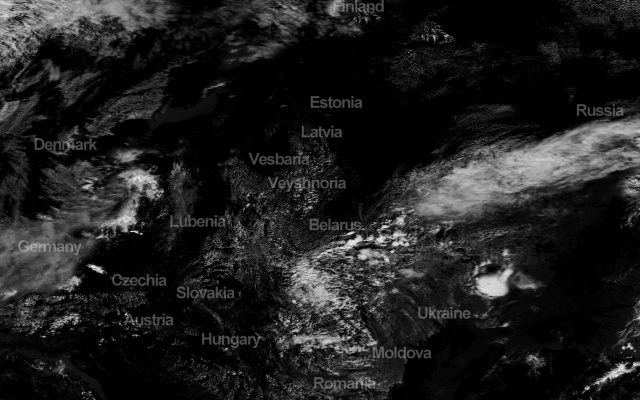Introduction
A military exercise is a hybrid construction that lies somewhere between reality and fiction, one which communicates a message that has multiple interpretations by different audiences. The symbolic interpretations and projections that are inherent in such an undertaking as Zapad-17 can perhaps be somewhat revealed through the lens of Jean Baudrillard and especially his understanding of hyper-reality. This has been popularized through the works of such people as Peter Pomerantsev in his book Nothing is True and Everything is Possible, who describes a constructed and surreal projected reality without limits in contemporary Russia. However, to understand the practical dimensions, fewer theoretical constructs are needed. Military diplomacy has been described as being part of a toolkit of international realpolitik, being used as a means to preserve the status quo through supporting allies and counterbalancing enemies/opponents.1
A number of claims were made concerning the possible deceptive nature of Zapad-17 and in order to investigate this possibility, there needs to be a tool to understand the nature and role of military deception. Maskirovka has been a centuries old practice of concealment and deception, which was popularized during the Soviet period. This article seeks to understand how the Zapad-17 exercise was reported by the Russian state international media outlets Sputnik and TASS. Was the reporting by Sputnik and TASS at the time of Zapad-17 an exercise in framing an alternative reality, engaging in military diplomacy, or an exercise of deception?
Baudrillard and Hyper-Reality
It should be noted that Jean Baudrillard is a controversial figure, his writings and theories provoke strong emotional responses either in support or in opposition.2 The focus and unique aspect of Baudrillard is his “media theory distinguishes itself from discussions of media ideology and spectacle precisely in the efficacy this concept imparts to media products to eclipse and produce our reality”.3 Baudrillard (1976) stated that simulation, abstraction, and hyper-reality are all ultimately increasingly defining our contemporary reality. This is because of the use and abundance of media, signs, and symbols that inundate our culture that “reality” has become inseparable in a media-dominated contemporary world that is saturated with information and communication.4 The blurring of reality and mediated experience is what Baudrillard refers to as being hyper-reality. Baudrillard5 outlined a number of successive phases that culminate in hyper-reality: a reflection of a basic reality; masking and perverting a basic reality; masking the absence of a basic reality; and finally bearing no resemblance to reality whatsoever, is its own pure simulacrum.
There have been attempts to analyze and interpret media representations that can lead to war through a Baudrillardian lens. One such article, with an emphasis on public relations, undertook the study of a campaign by a group called Citizens for a Free Kuwait through the work of the lobbying firm Hill and Knowlton. This included the infamous “incubator atrocity” story that was given as testimony before political hearings that helped sway political opinion that enabled the First Gulf War. “Hill and Knowlton put out a sign that did not represent reality and that nonetheless moved government leaders to choose to go to war. The power of the sign becomes credible from the postmodernist view”.6 Thus a sign with no actual grounding in reality was perceived as being real, an example of the hyper-reality of simulacrum. But why undertake such projects, what is the goal?
The motivation and attraction of manufacturing hyper-reality seems to be found in the nature of power and politics. In terms of the greater significance and meaning of hyper-reality to wider society is its ability to limit human participation to that of consumer or responder (implying passivity and/or reactive) rather than producer or initiator (active and/or proactive) of fabricated reality.7 Politics is able to generate power through the hyper-reality of influencing perception.
Power in hyper-reality, derives from controlling the means of simulation, dominating the codes of representation, and managing the signs of meaning that constitute what hyper-reality is taken as being at any particular time. By setting the limits of what is hyper-real, and therefore at least temporarily “real,” movements on the mediascapes appear to set the agendas, determine loyalties, frame conflicts, and limit challenges to the prevailing organisation of what is or is not taken as being real.8
As noted by Luke, hyper-reality demonstrates that human needs are based upon pre-existing cultural codes of expectations that are communicated to audiences to consume and react to. In addition to the use of Baudrillard to understand communications that led to conflict, other studies have focused upon using his theories to comprehend state-building processes in post-conflict territories.9 This is of particular interest to this paper given the fictitious territory that was created for the scenario of Zapad-17. Hehir10 notes that “the discourse of intervention and state-building reproduces power asymmetries,” which is often framed in sets of values, norms, and a core humanitarian mission. This creates a hyper-reality of a weak state to be administered and a hyper-reality of creating an idealized model of a Western-style “rehabilitated” state. It is a contest of projecting a problem or crisis that requires a certain predetermined solution. This is a “game” where illusions steadily replace reality, a path where technological “perfection” can lead to the realization of moral “perfection.” This section has dealt with the subject of politics creating a hyper-reality, there are also other groups, such as the military that have an established and an emerging tradition of communicating with stakeholders.
Sputnik’s Coverage of Zapad-17
Background
A military exercise has a number of uses and intents, such as the practice of command, control, and communication of military forces in a controlled environment that can prepare them for when or if a war breaks out. This is a tangible and practical application. There is also an intangible and symbolic application in terms of communication value, it sends a signal to different stakeholders (which are open to multiple interpretations) concerning shaping the perception of military capacity and foreign policy intent. This has been seen in such regular military exercises in South Korea near the Demilitarized Zone (to show resolve and unity in face of North Korea) or the Russian naval exercise that occurred in August 2000 (to try and demonstrate resurgent military strength and resolve in the wake of Kosovo).
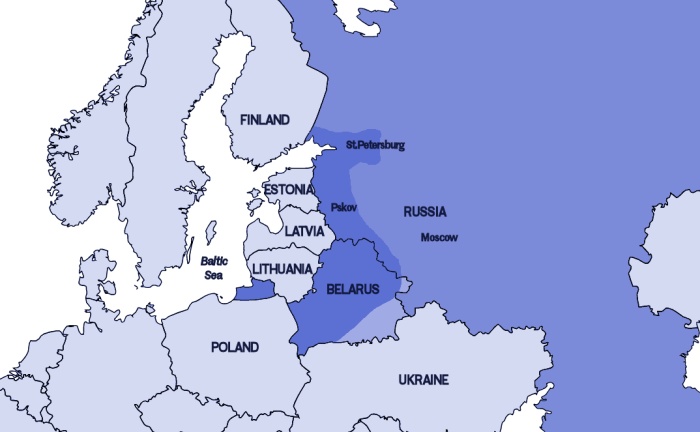
Oficjalne dane dotyczące rosyjskich manewrów Zapad-2017. Ciemnym niebieskim zaznaczono obszary Rosji i Bialorusi, gdzie odbywały się ćwiczenia. Według ministrów obrony Rosji i Białorusi w ćwiczeniach uczestniczyło: 12700 żołnierzy, w większości umiejscowionych na terenie Białorusi, ok. 70 samolotów i helikopterów, 680 jednostek ciężkiego sprzętu wojskowego, w tym 250 czołgów i 200 dział i wyrzutni, 10 okrętów wojennych.
Zapad military exercises were held in the years 2009 and 2013,11 prior to the third strategic military exercise bearing this name. The Russian Ministry of Defense announced that Zapad-17 would involve 12,700 troops,12 70 military aircraft and helicopters, 10 warships, and 680 pieces of military equipment (trucks, tanks, artillery … etc.) to take place on the territory of Russia and Belarus from 14–20 September 2017.13 In this exercise, the scenario was laid out on the Russian Ministry of Defense website:
The exercise stipulates that some extremist groups have penetrated to the territories of the Republic of Belarus and the Kaliningrad region of the Russian Federation in order to carry out terrorist attacks and destabilize the Union State of Russia and Belarus. The simulated extremists are supported from outside by receiving logistics assistance and military hardware by air- and sealift.14
The scenario involved Russian and Belarusian forces fighting an “extremist/terrorist” element in a non-existent break-away state named Veyshnoria that was simulated as bordering Poland and Lithuania.15 Zapad-17 was characterized as being a “purely defensive one,” however this is not how some others interpreted the “reality” of the military exercise. NATO put the estimated troop numbers involved in Zapad-17 as being in the range of 70,000–100,000 personnel, not believing the officially given figures by Belarus and Russia.16 A Swedish military observer on Zapad-17 described the exercise as “normal military business” and assessed the official Belarusian/Russian personnel figures as being accurate.17 Some more alarmist interpretations of Zapad-17, included understanding its “reality” as being a possible Trojan Horse (i.e. maskirovoka) to enable an invasion, pointing to Russian military drills in 2008 and 2013 that occurred shortly before the 2008 Georgian-Russian War and events in Crimea.18 Not all foreign analysts interpreted Zapad-17 in such a directly threatening light.
One such observer, Jyri Raitasalo from the Finnish National Defense University noted that “Moscow’s message of larger than life military power has been eagerly amplified by Western politicians and media outlets.”19 In between the lines, there is a possible implication of the use of military diplomacy in use, where the original message is picked up and hyped by the West thereby internalizing the symbolic message of the military exercise. Raitasalo argues that the West is currently displaying a poor understanding “of the workings of great-power politics and adversarial great-power behavior. […] The exercise (Zapad-17) has not even started and our societies have been fretting about it for at least six months.”20 Other commentators and observers of Zapad-17 also pointed to the hyper-reaction to the hyper-reality of the military drills. “Also Lithuania didn’t get invaded and Belarus seems like it will be OK.”21 The next sub-section will move to the case study, which involves an analysis of Russian media content on covering Zapad-17 during the period of the military exercise.
Method and Sample
The approaches to textual analysis shall include content analysis (quantifications of different elements in text), argumentation analysis (the structure of argumentation used), and the qualitative analysis of ideas in the content (with a focus on hyper-reality).22 The combination of these approaches is expected to yield results on the ontology (what exists) and epistemology (knowledge and how we “know” things) of mass-mediated textual depictions of the “reality” of the Zapad-17 event within the context of the wider geopolitical tensions. The objects of study include power, people, policy, oppression and freedom, war and peace, and so forth.23 The mass media texts then contextualize the relationships according to perceived and projected power in the constructed social world order of mankind, such as justice and injustice, powerful and powerless, legitimate and illegitimate, worthy and unworthy. The analysis of the framing of the empirical material of this case study will follow the method of Entman.24
- Defining effects or conditions as problematic;
- Identifying causes;
- Conveying a moral judgment;
- Endorsing remedies and improvements.
The above-mentioned method will be applied to news content appearing on Sputnik International (https://sputniknews.com) and TASS news agency (http://tass.com) over the period 14–20 September 2017 (the days of the Zapad-17 military exercise was conducted) as well as before and after these dates. These media outlets were selected because they are communicating to an international audience (being part of Russia’s public diplomacy through international broadcasting) and they are both state-owned (therefore most likely to convey the official Russian government perspective and “realities”). The Sputnik International (formerly RIA Novosti) brand came into being on 10 November 2014 is a state-owned international media outlet based in Moscow, with regional offices and content published in some 30 languages.25 TASS is a state-owned news agency founded in 1902, and having news bureaus in some 63 countries.26 A search was conducted on the websites of Sputnik International and TASS news, using the websites search function and using the key words “Zapad 2017” in August 2018. A total of 114 individual articles were found on Sputnik International for analysis. There were a total of 59 results on the TASS search. Please see chart one below for details on the articles.
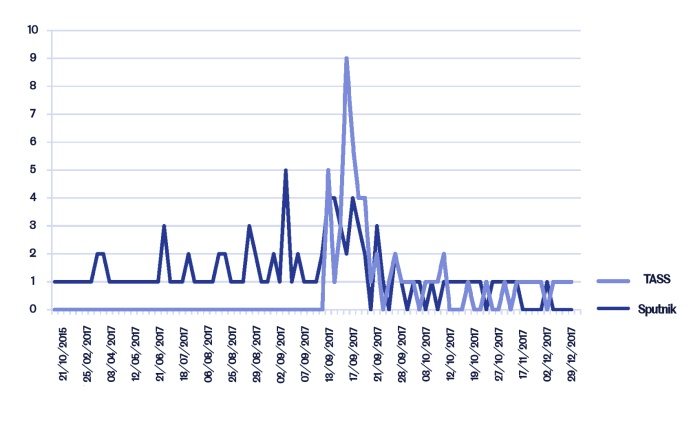
Materiały Sputnik i TASS na temat manewrów Zapad-17.
Sputnik’s and TASS’s Coverage and Framing
The first article on Zapad-17 appearing on Sputnik’s news coverage appeared on 21 October 2015 and the last article observed on 4 December 2017. On TASS, the first article appeared on 14 September 2017 and the last article observed appeared on 25 April 2018. Sputnik’s coverage was more intensive and longer term than what appeared in TASS. There were several clusters of different frames that was observed across the two news agencies reporting of the Zapad/17 military exercise. One frame was the “technical” frame that involved reporting on the planning and execution of the war games. A second frame was the “hysteria and hypocrisy” frame that centered on the idea of the West’s overly exaggerated reaction against the Zapad-17 and the West’s own military activities. Thirdly was the “vindication” frame that was involving a link between the two previously mentioned frames through “admissions” by the West that Zapad-17 was not the threat that it was hyped up to be. See charts two and three below for an overview of the distribution of these frames across Sputnik’s and TASS’s reporting of the Zapad-17 military exercise.
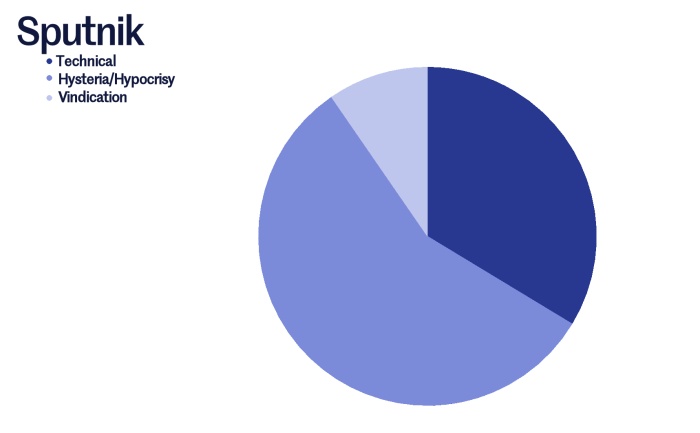
Proporcje kontekstów wiadomości publikowanych przez Sputnik (od najciemniejszego): techniczny, histeria/hipokryzja, oczyszczenie z zarzutów.
The focus of Sputnik’s news frames was on the elements of hysteria and hypocrisy, namely the tone that the West (Poland, Baltic States, Finland, and Sweden in particular) were overreacting and their “hysterical” attitude towards the Zapad-17 military exercise. Another aspect was the hypocrisy, which involves the concept of maskirovka, but applied to NATO and Sweden in particular with the charge that they are using the “cover” of Zapad-17 in order to conceal/camouflage the movement of troop and equipment and to justify significant military exercises that are directed at Russia and her allies. The general tone of this frame was dismissive of the concerns about Zapad-17 and accusative of the actions and intent of the West. Articles were politically charged in nature and made rhetorical use of logos (logic) and pathos (emotion). An example of this type of article appeared on 4 September 2017 (10 days before Zapad-17) under the headline “Sweden loses traces of non-alignment to NATO in major exercise with US troops.”27 This article referred to the military exercise Aurora-17, which occurred from 11–29 September 2017 (coinciding with Zapad-17) and projects a negative tone at the “message” such an exercise denotes concerning Swedish neutrality/non-alignment in addition to the possible “anti-Russian” aspects (owing to the likely opponent of the exercise).
Technical issues were the second largest frame, which includes news coverage of the physical and political aspects of the military drills, whether this was on specific military equipment and tactics (use of logos) or political dignitaries (such as Vladimir Putin or Alexander Lukashenko) (applying ethos) inspecting Zapad-17. This category of frame seemed to be more in-line with the pursuit of military diplomacy by emphasizing the successful nature of the military drills and the projected reality of the power and effectiveness of weapons and tactics used in the exercise. The strategic message of Zapad-17 was also evident in this category, which was purely defensive in nature and intended to prepare the countries to protect themselves. An example of such reporting can be found 20 September 2017, which emphasized the successful conclusion of the military exercise against the “imaginary enemy.”28 The last frame category connects the technical frame and the hysterical/hypocritical frame.
The vindicated frame is an attempt to logically bridge the Russian hyper-reality of a Zapad-17 as defensive anti-terrorist military exercise and to counter-act the alternate hyper-reality of neighboring countries of Zapad-17 posing a significant risk and threat. There is generally a logical tone used to make the point that the Russian message is vindicated through the use of the ethos of foreign commentators confirming the non-threatening nature of the military drills. A typical example of appeared on 17 November 2017 (one month after Zapad-17) when the results of a study by a Finnish defense analyst who stated that the military drills were defensive in nature and did not constitute a threat to neighboring countries.29 Thus the message implies the “truthfulness” of the official Russian hyper-reality and the “deceptiveness” of NATO and the West’s alternative hyper-reality. How does TASS’s reporting compare to Sputnik’s?
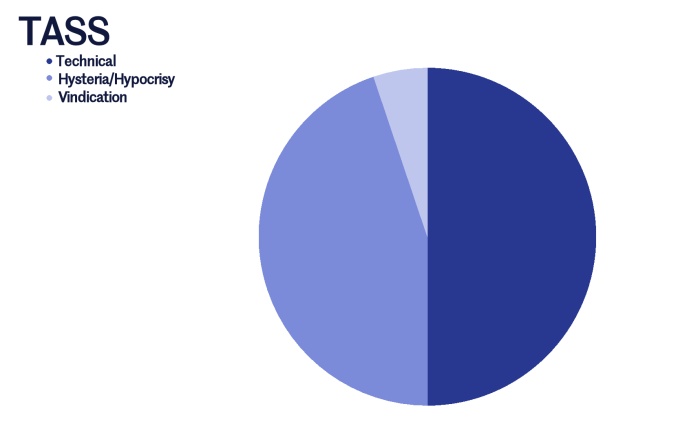
Proporcje kontekstów wiadomości publikowanych przez TASS (od najciemniejszego): techniczny, histeria/hipokryzja, oczyszczenie z zarzutów.
There is a more even distribution in the TASS reporting on Zapad-17 between the technical and hysterical/hypocritical news frames observed. Technical framing occurs slightly more often than the hysterical/hypocritical news frames. When examining the articles, extensive use of logos and ethos is made in the technical frame category. There is a great deal of emphasis on stressing the defensive and non-threatening nature of Zapad-17 (this is a common strategic narrative of both media outlets) via the use of facts, figures, and key political or military figures. The key messages beyond this strategic message are the testing of the capability and capacity of Belarusian and Russian militaries to respond to irregular military threats against them, and the effectiveness of the military personnel and equipment. An article appearing on the 19th of September 2017 explaining the logic and goals of Zapad-17, and it addressed each and every one of these messages.30
In a close second, the hysterical/hypocritical news frames came, and there are some variations in the tone of the articles when compared with those news items that appeared in Sputnik. There was an observable note in the reliance of ethos in this category where political and military officials refuted, rather than ridiculing the concerns of neighboring countries. It was also noted than there was much greater emphasis devoted to refuting NATO/Western claims, rather than pointing out instances of “hypocrisy.” The following article headlined “Kremlin slams hype over Zapad-2017 military drills as provocative” makes use of logical statements by important figures from Russia and NATO in order to reduce the public threat perception and the perceived legitimacy of Western/NATO allegations.31 This is an exercise in emphasizing the validity of the official Belarusian/Russian hyper-reality of the Zapad-17 scenario logic and aims. There were remarkably few articles appearing in the vindication news frame. There was still a bridging function between the different frame categories observed, where the vindication aspect was found in the logic that Zapad-17 was in the end run in the manner told in advance by Belarus and Russia and not by the various foreign critics. An article appearing in this framing category also stressed the transparent nature of Zapad-17 as an additional counter to the foreign threat/risk frame, by focusing on the nature of the NATO military observers present at the military drills.32 This article quotes the words of Lavrov (ethos), but “backs-up” these words through the implied logic of the NATO military observers present at Zapad-17.
Conclusion
This paper is not intended as an ethical or moral judgment of the news content that was collected and analyzed on Zapad-17. Rather this is an exercise in understanding how mass-mediated framing of hyper-reality appears and works through a limited sample of outlets and articles in order to derive an indicative result. An activity such as a large-scale military exercise, such as Zapad-17, is highly susceptible to various hyper-reality constructs. This was evident in the opposing hyper-realities communicated by Russia versus those communicated by the West, NATO and Ukraine. In terms of the approach to news framing and the creation of a hyper-reality, what did these Russian state news agencies do?
The approach to news framing, pertaining to the communication of foreign policy that was noted by Entman33 envisaged: the definition of a problem; identification of causes; conveying a moral judgment; and suggesting a remedy or improvement. Within the sample of news that was collected and analyzed there were two interconnected problems. One of them is the practical issue of needing to train and prepare the Belarusian and Russian militaries to increase their capability, capacity and effectiveness (military diplomacy). The identification of the cause lies in the nature of evolving security risks and threats, and the need to meet these threats in a united manner. The moral judgment is found in the strategic message of Zapad-17 being a defensive anti-terrorist exercise and the right to protect national sovereignty in the face of irregular military threats. The remedy for this situation is the ability to hold large-scale military drills, such as Zapad-17.
The other problematic situation that was identified in the news reporting appearing in Sputnik and TASS is the “misrepresentation” (maskirovka) of the risk and threat posed by Zapad-17 by some other countries. The causes are found in the articles, implying the opponents and competitors of Russia are doing this deliberately in order to restrict Russia’s operational choices (the conducting of large-scale military drills in the manner they wish to) and widening their operational choices (as an excuse as a means to increase tactical and operational military balances – increasing military capability and capacity). The moral judgment is that this communication is false and misleading. The vindication frames demonstrated the remedy/improvement was to be found in having more faith in Russian communications (the implication being less faith in radically opposing views).
To turn to the issue of how Baudrillard34 explained the phases that result in hyper-reality: reflecting basic reality; masking and perverting a basic reality; masking the absence of a basic reality; and resulting in no resemblance to reality. Military exercises, although occurring in the physical realm of reality are an exercise in the creation of a hyper-reality that is simultaneously intended to reduce tangible risk (such as sparking a possible war) and still achieve intangible results (to increase the reputation and perception of professionalism and power of the armed forces). The basic reality communicated by Sputnik and TASS of Zapad-17 is that a large-scale military drill will take place in Western Russia and Belarus that is transparent and within the legal framework of the OSCE’s 2011 Vienna Document. Hence there is the emphasis of legality and transparency of the drills. The masking and perverting of the basic reality comes in the form of the defensive military operation against an imaginary enemy, which is also found in part of the script of the scenario for the drills that details those enemies are receiving support from foreign powers. The ultimate hyper-reality of Zapad-17 is achieved with the creation of a fictitious break-away “terrorist/separatist state” that borders the real Poland and Lithuania.
BIO
Associate Professor Greg Simons is originally from New Zealand, but is now based at the Institute for Russian and Eurasian Studies at Uppsala University and at the Department of Communication Sciences at Turiba University (Riga, Latvia). He specialises in international political communication, such as public diplomacy or the relationships at play between politics and information within the context of armed conflict. Some of his work can be found at https://uppsala.academia.edu/GregSimons.
* Coverphoto: "News from Elsewhere", Vitalij Strigunkov, 2018. Courtesy of the artist.
[1] Swistek, G. (Spring 2012), The Nexus Between Public Diplomacy and Military Diplomacy in Foreign Affairs and Defence Policy, Connections 11(2), pp. 79-86: page 86.
[2] Merrin, W. (2005), Baudrillard and the Media, Cambridge: Polity Press: page 5.
[3] Ibid.: page 152.
[4] Arva, E. L. (Winter 2008), Writing the Vanishing Real: Hyper-Reality and Magical Realism, Journal of Narrative Theory 38(1), pp. 60-85.
[5] Baudrillard, J. (1994), Simulacra and Simulation, Michigan (MI): Michigan University Press: page 11.
[6] Mickey, T. J. (Fall 1997), A Postmodern View of Public Relations: Sign and Reality, Public Relations Review 23(3), pp. 271-284: page 282.
[7] Luke, T. W. (1991), Power and Politics in Hyper-Reality: The Critical Project of Jean Baudrillard, The Social Science Journal 28(3), pp. 3447-367: page 347.
[8] Ibid: pages 362-63.
[9] Hehir, A. (2011), Hyper-Reality and State-Building: Baudrillard and the Unwillingness of International Administrations to Cede Control, Third World Quarterly 32(6), pp. 1073-1087.
[10] Ibid: page 1075.
[11] Janjevic, D., What are Russia’s Zapad War Games?, Deutsche Welle, https://www.dw.com/en/what-are-russias-zapad-war-games/a-39702331, 14 September 2017 (accessed 10 August 2018).
[12] A military exercise that involves more than 13,000 troops must invite observers to the military drills according to the Organisation for Security and Cooperation in Europe’s 2011 Vienna Document, which Russia is a signatory to.
[13] Zapad-17: Joint Strategic Exercise, Russian Ministry of Defence, http://eng.mil.ru/en/mission/practice/more.htm?id=12140115@egNews, accessed 8 August 2018.
[14] Ibid.
[15] Sharkov, D., Russia’s Zapad 17 War Game: What We Learned From Putin’s Sparring Match That Was ‘All About NATO’, Newsweek, https://www.newsweek.com/russia-zapad-war-game-what-learned-putin-sparring-match-nato-668930, 21 September 2017 (accessed 10 August 2018).
[16] Janjevic, D., What are Russia’s Zapad War Games?, Deutsche Welle, https://www.dw.com/en/what-are-russias-zapad-war-games/a-39702331, 14 September 2017 (accessed 10 August 2018); Röpcke, J., Putin’s Zapad 2017 Simulated a War Against NATO, Bild, https://www.bild.de/politik/ausland/bild-international/zapad-2017-english-54233658.bild.html, 19 December 2017 (accessed 10 August 2018).
[17] Goncharenko, R., Zapad-2017: ‘Normal Military Business’, Deutsche Welle, https://www.dw.com/en/zapad-2017-normal-military-business/a-40710010, 27 September 2017 (accessed 10 August 2018).
[18] Sharkov, D., Russia’s Zapad 17 War Game: What We Learned From Putin’s Sparring Match That Was ‘All About NATO’, Newsweek, https://www.newsweek.com/russia-zapad-war-game-what-learned-putin-sparring-match-nato-668930, 21 September 2017 (accessed 10 August 2018); Janjevic, D., What are Russia’s Zapad War Games?, Deutsche Welle, https://www.dw.com/en/what-are-russias-zapad-war-games/a-39702331, 14 September 2017 (accessed 10 August 2018).
[19] Raitasalo, J., Russia’s Zapad-17 Has Already Succeeded, Defence One, https://www.defenseone.com/ideas/2017/09/russias-zapad-17-has-already-succeeded/140846/, 8 September 2017 (accessed 10 August 2018).
[20] Ibid.
[21] Kofman, M., Zapad Watch – Summary of Day Seven (Last Day), Russian Military Analysis: A Blog on the Russian Military, https://russianmilitaryanalysis.wordpress.com/2017/09/21/zapad-watch-summary-of-day-seven-last-day/, 21 September 2017 (accessed 10 August 2018).
[22] Boréus, K. Bergström, G. (2017), Analysing Text and Discourse: Eight Approaches for the Social Sciences, Thousand Oaks (CA): Sage Publishing: page 9.
[23] Boréus, K. Bergström, G. (2017), Analysing Text and Discourse: Eight Approaches for the Social Sciences, Thousand Oaks (CA): Sage Publishing: pages 1-2.
[24] Entman, R. M. (2004), Projections of Power: Framing News, Public Opinion, and U.S. Foreign Policy, Chicago: University of Chicago Press: page 5.
[25] About Us, Sputnik International, https://sputniknews.com/docs/about/index.html, (accessed 11 August 2018).
[26] About Us – TASS Today, TASS Russian News Agency, http://tass.com/today, (accessed 11 August 2018).
[27] Sweden Losing Traces of Non-Alignment to NATO in Major Exercise With US Troops, Sputnik International, https://sputniknews.com/military/201709041057073567-sweden-exercise-criticism/, 14 September 2017 (accessed 11 August 2018).
[28][28]Russia, Belarus Wrap Up Zapad 2017 Joint Military Exercises, Sputnik, https://sputniknews.com/videoclub/201709201057548375-zapad-2017-war-games-over/, 20 September 2017 (accessed 11 August 2018).
[29] ‘Not Anti-NATO’: Finland Admits Russian War Games Were ‘Purely Defensive’, Sputnik, https://sputniknews.com/military/201711171059184434-russian-drills-purely-defensive/, 17 November 2017 (accessed 11 August 2018).
[30] Zapad-2017 Exercise Puts Russian Army’s “Nervous System” to Test, TASS, http://tass.com/defense/966366, 19 September 2017 (accessed 11 August 2018).
[31] Kremlin Slams Hype Over Zapad-2017 Military Drills as Provocative, TASS http://tass.com/politics/965660, 14 September 2017(accessed 11 August 2018).
[32] Top Diplomat Says NATO’s Allegations About Zapad-2017 Drills Turn Out to be False, TASS, http://tass.com/politics/976434, 20 November 2017 (accessed 12 August 2018).
[33] Entman, R. M. (2004), Projections of Power: Framing News, Public Opinion, and U.S. Foreign Policy, Chicago: University of Chicago Press: page 5.
[34] Baudrillard, Op cit: page 11.



